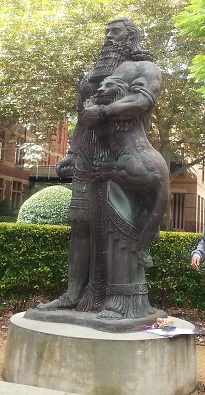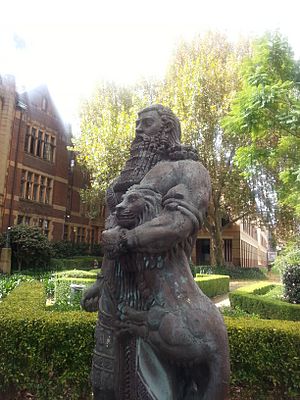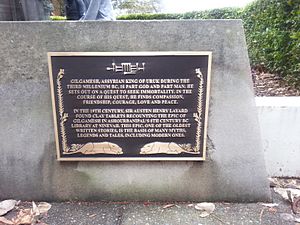Statue of Gilgamesh, University of Sydney facts for kids
The Statue of Gilgamesh is a large sculpture located at the University of Sydney in Camperdown. It was created by artist Lewis Batros and was officially shown to the public in the year 2000. The statue is 2.5 meters (about 8 feet) tall.
This impressive statue shows Gilgamesh, an ancient king from the city of Uruk in Sumer. His amazing adventures are told in the Epic of Gilgamesh, a very old poem written in the Akkadian language. The poem was created around 2000 BC, but it is based on even older stories.
The Assyrian community, through the Gilgamesh Cultural Centre, gave the statue to the University of Sydney. It was a gift to celebrate the university's 150th anniversary. Dame Leonie Kramer officially unveiled the statue on October 15, 2000. You can find it on the University's Camperdown/Darlington Campus, between the Old Teachers College Building and the Women's Sports Centre. It faces towards the Charles Perkins Centre.
Who Was Gilgamesh?
Gilgamesh was a powerful king of Uruk, a city in ancient Mesopotamia. Stories say he was a demigod, meaning he was part god and part human. He was two-thirds god from his mother, Ninsun, and one-third human from his father, King Lugalbunda.
Gilgamesh was known for his incredible strength. He built the strong city walls of Uruk to protect his people. He also went on many dangerous adventures. For example, he fought a fearsome demon named Humbaba (or Huwawa) with his friend, the wild man Enkidu. Together, they defeated Humbaba and brought his head back to Uruk.
Gilgamesh and Enkidu also defeated the Bull of Heaven, which was sent by the angry goddess Ishtar. These victories show Gilgamesh's great power. The statue represents Gilgamesh as a wise and strong king who protected his people. It celebrates his achievements and his role as a hero.
The Story on the Statue
Next to the Statue of Gilgamesh, there is a bronze plaque. This plaque has a special message that tells a bit of Gilgamesh's story. It says:
Gilgamesh, Assyrian King of Uruk during the third millennium BC, is part god and part man. He sets out on a quest to seek immortality. In the source of his quest, he finds compassion, friendship, courage, love and peace. In the 19th century, Sir Austen Henry Layard found clay tablets recounting The Epic of Gilgamesh in Ashourbanipal's 8th century BC library at Nineveh. This epic, one of the oldest written stories, is the basis of many myths, legends and tales, including modern ones.
This inscription explains that Gilgamesh went on a journey to find a way to live forever. During his journey, he learned important lessons about kindness, friendship, bravery, love, and inner peace. The plaque also mentions that the ancient story of Gilgamesh was found on clay tablets in the 1800s. This epic poem is one of the oldest written stories in the world and has inspired many other myths and legends.
About the Artist: Lewis Batros
The artist who sculpted the Gilgamesh statue is Lewis Batros. He is a talented sculptor whose works can be seen in different places around the world. Some of his sculptures are in Fairfield and Sydney Olympic Park in Australia. You can also find his art in Moscow and the United States.
Lewis Batros often gets ideas for his art from Assyrian history, stories, and culture. He earned a degree in fine art in 1986 and moved to Australia in 1990. Many of his sculptures reflect his Assyrian heritage.
- Ziolkowski, T. (2011). Gilgamesh among us: Modern encounters with the ancient epic. Ithaca: Cornell University Press.






